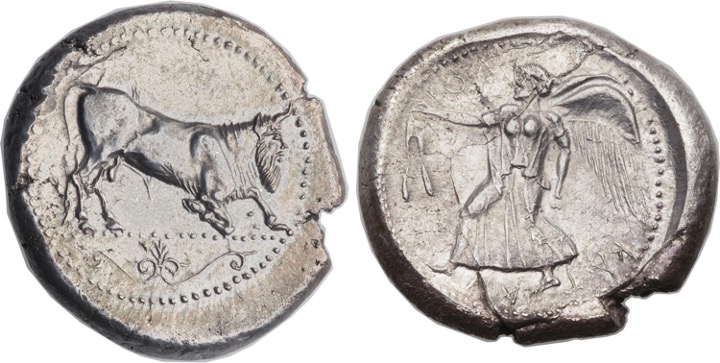460 BCE - 445 BCE | KATANAION
Overstriking coin
SO_148_-_Catana_(tetradrachm).jpg
[1]
|
|
Sale(s)Sale(s) ᵖ:
|
Heritage World Coin Auctions ; NYINC Signature Sale 3037, 04 Jan. 2015, 30860 ; Roma Numismatics, 5, London, 23 March 2013, 94
|
| Private collection(s)Private collection(s) ᵖ:
|
Comery collection ; The California collection
|
|
Description
| ObverseInscription or printing placed on the obverse.:
|
Man-faced bull (river-god Amenanos) right, kneeling. In exergue, palmette. Border of dots.
|
ReverseInscription or printing placed on the reverse.:
|
KATANAION (Greek) Nike advancing left, wearing long pleated peplos, holding taenia in her outstretched right hand, wreath in left. In left field, H. Border of dots.
|
Mint and issuing power
| MintIdentifies the place of manufacture or issue of a numismatic object.:
|
Catana
|
Ancient regionAncient region.
|
Sicily
|
Modern countryModern country: Italy
|
AuthorityIdentifies the issuing power. The authority can be "pretended" when the name or the portrait of X is on the coin but he/she was not the issuing power. It can also be "uncertain" when there is no mention of X on the coin but he/she was the issuing power according to the historical sources:
|
|
Chronology
| FromIdentifies the initial date in a range assigned in a numismatic context. 460 BCE toIdentifies the final date in a range assigned in a numismatic context.. 445 BCE
|
Classical 480-323 BC  periodTime period of the numismatic object. periodTime period of the numismatic object.
|
Physical description
MetalThe physical material (usually metal) from which an object is made.: Silver 
|
WeightWeight of the numismatic object (in grams). in grams: 17.317.3 g <br />17,300 mg <br />
|
DenominationTerm indicating the value of a numismatic object. Examples: tetradrachm, chalkous, denarius.: tetradrachm 
|
AxisDescribes the directional relationship between the obverse and reverse of a numismatic object.: 33 mm <br />0.3 cm <br />
|
| DiameterDescribes diameter of an object (in mm).: 2929 mm <br />2.9 cm <br />
|
StandardStandard.: Attic
|
References
Description
| ObverseInscription or printing placed on the obverse.:
|
|
ReverseInscription or printing placed on the reverse.:
|
|
Mint and issuing power
| MintIdentifies the place of manufacture or issue of a numismatic object. ᵖ:
|
|
Ancient regionAncient region. ᵖ
|
|
Modern countryModern country:
|
AuthorityIdentifies the authority in whose name (explicitly or implicitly) a numismatic object was issued. ᵖ:
|
|
Chronology
| FromIdentifies the initial date in a range assigned in a numismatic context. toIdentifies the final date in a range assigned in a numismatic context..
|
periodTime period of the numismatic object.
|
Physical description
References
References
- ^ SNG ANS 3 Sicily
- ^ Arniold-Biucchi, Carmen (1990), The Randazzo hoard 1980 and Sicilian chronology in the early fifth century B.C., Numismatic Studies 18, New York, 77 p., 20 pl.
- ^ Hoover, Oliver D. (2012), The Handbook of Greek Coinage Series. 2. Handbook of the Coins of Sicily (Including Lipara). Civic, Royal, Siculo-Punic, and Romano-Sicilian Issues. Sixth to First Centuries BC, Lancaster-London, 489 p.

